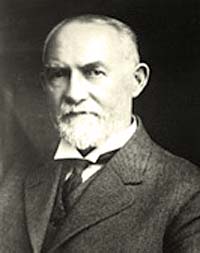- James Withycombe
Infobox Governor
name= James Withycombe
caption=
order=15th
office= Governor of Oregon
term_start=January 12 ,1915
term_end=March 3 ,1919
lieutenant=
predecessor=Oswald West
successor=Ben W. Olcott
birth_date= birth date|1843|3|21|mf=y
birth_place=Tavistock, Devon ,England , U.K.
death_date= death date and age|1919|3|3|1843|3|21|mf=y
death_place=Oregon
spouse= Isabel Withycombe
profession=Farmer
party= Republican
footnotes=James Withycombe (
March 21 ,1843 -March 3 ,1919 ) was a British-born American politician, a Republican, and the 15th Governor ofOregon . Prior to entering politics he was farmer and sheep rancher in theTualatin Valley , leading to appointment as the state's veterinarian and then as head of what became theOregon State University Extension Service.Early life
Born to Thomas and Mary Ann Withycombe in
Tavistock, Devon shire,England , English tenant farmers in 1843. Withycombe emigrated to the United States with his parents in 1871, settling on a farm nearHillsboro, Oregon . After turning 17, he spent four years working on his father's farm. In 1873, Withycombe purchased his own convert|100|acre|km2|sing=on parcel on the Horace Lindsay Land Claim, later expanding his holdings to convert|256|acre|km2. Agriculture became Withycombe's passion, becoming a prosperous livestock breeder and establishing a reputation as a successful scientific farmer. OnJune 6 1875 in Washington County he married Isabell Carpenter, and the couple would have a daughter and three sons together. [County governors both die in office. "Hillsboro Argus ",October 19 1976 .]Farmer and educator
His success led to his involvement in local farming organizations. He became a charter member of the Farmington Grange, and later became a leader in the state grange movement. From these platforms, Withycombe's efficient, innovative, and profitable farming methods became a model for farmers across the Pacific Northwest. His stature gained him an appointment as State Veterinarian in 1889, where he would diligently work to improve conditions of livestock health around the state.
Although mostly self-educated, he was sought after by the Oregon Agricultural College at Corvallis (now
Oregon State University ) in 1898 to head up the college's experimental farming station. He received his Master's Degree in Agriculture 1891 from OAC. [cite book |last=Klooster |first=Karl |title=Round the Roses II: More Past Portland Perspectives |year=1992 |publisher= |id=ISBN 0-9619847-1-6 |pages=118 ] Using this position to advance Oregon agriculture, he would play a major part in introducingalfalfa andclover toEastern Oregon , laying the groundwork for the region's future agricultural economy.Withycombe also became heavily involved in Oregon's agricultural industry, serving as president of the North Pacific Wool Growers and Northwest Sheep Breeders Associations. His tenureship on the board of the Oregon Academy of Sciences saw the dairy industry's profits rise from $2.5 million to $20 million. Such accomplishments built up respect for Withycombe statewide and gained the state Republican Party's attention.
Governorship
Withycombe would enter politics in the 1906 primary, losing the Republican gubernatorial nomination. The 1910 election of controversial Democratic Governor
Oswald West energized Oregon Republicans, who tapped Withycombe for the 1914 gubernatorial race. He handily defeated challenger Charles Smith; the first Republican Governor to assume office via election sinceT. T. Geer in 1903.As Governor, James Withycombe vigorously promoted agricultural development. A notable proposal from his administration was to ask the Legislative Assembly to subsidize
flax production as a prison industry.The Withycombe Administration backed the "Good Roads" movement, creating the Oregon Highway Commission while in office. With the new commission in place, a large road-building program was initiated, establishing many of Oregon's modern state routes and highways.
Upon the U.S. entry into the
First World War , Governor Withycombe took a vocal and patriotic position in support of the war effort. He encouraged volunteer military service, and promoted the state's war industries.While in office, he took a strong position against
labor unions . He spoke out publicly against theIndustrial Workers of the World , claiming that it terrorized labor and would cripple industry following several instances of I.W.W. threats to disrput production in 1917. He organized veterans of theSpanish-American War into an Oregon State Defense force, and encouraged citizens in Eastern Oregon to form self-defence committees to defend the state against violent labor agitators. Withycombe used his powers as Governor to prevent a shipyard strike in Astoria, by calling out the National Guard.His 1918 reelection campaign capitalized on his wartime acts, portraying him as a wartime Governor actively protecting the state and aiding the defense of the United States. These efforts gained him a second term, of which he only served two months. James Withycombe died in office of a heart condition on
March 3 ,1919 , succeeded by Secretary of StateBen W. Olcott .References
* [http://www.osl.state.or.us/home/lib/governors/jwith.htm Oregon State Library]
External links
* [http://arcweb.sos.state.or.us/governors/withycombe/withymenu.html Oregon State Archives: Withycombe Administration] -Photo and public speeches of Governor James Withycombe.
Wikimedia Foundation. 2010.
